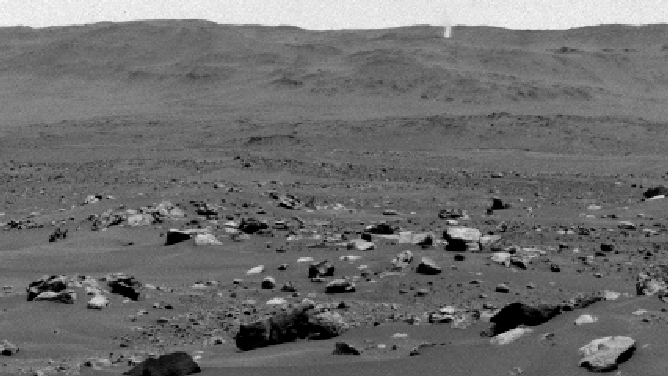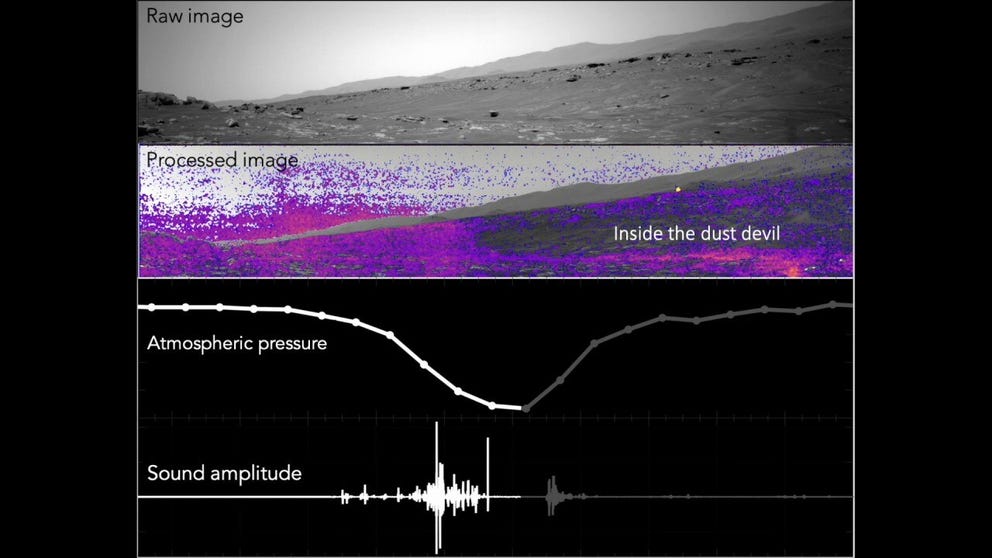NASA's Mars rover records mile-high dust devil moving across Red Planet
Scientists believe the images captured only the bottom 387 feet of the Martian dust devil. The Perseverance rover team was able to determine the height of the vortex by looking at its shadow.
NASA rover records a dust devil zooming across Martian landscape
Images from NASA’s Perseverance rover showing a Martian dust devil on Aug. 30, 2023, the 899th Martian day, or sol, of the mission. The video has been enhanced in order to show maximal detail and sped up 20 times and composed of 21 frames taken four seconds apart.(Video credit: NASA/JPL-Caltech via Storyful)
NASA's Perseverance rover was recently wheeling around on Mars and recorded a dust devil passing by in the distance, estimated to be more than a mile tall.
Dust devils are common on the Red Planet, where there is plenty of iron-rich dust to blow around. Planetary scientists are studying the weather on Mars through robotic missions to help improve atmospheric and weather models.
NASA said this particular dust devil happened on Aug. 30, or the 899th Martian day of Percy's mission.
NASA'S MARS ROVER INSTRUMENT MOXIE GENERATES ENOUGH OXYGEN FOR SMALL DOG
According to NASA, the image below was created with 21 image frames taken four seconds apart and then sped up 20 times.

The lower portion of a Martian dust devil was captured by one of the Navcams on NASA’s Perseverance rover on Aug. 30, 2023, the 899th Martian day, or sol, of the mission. (image: NASA/JPL-Caltech)
(NASA)
Using data from Perseverance, the rover's science team determined the dust devil was about 2.5 miles from the rover in a location known as "Thorofare Ridge." Moving at about 12 mph, the dust devil was estimated to be about 200 feet wide.
WITNESSING DUST DEVILS: NASA'S ROVER BRINGS NEW MEANING TO MARTIAN DUST STORMS
Scientists believe the images captured only the bottom 387 feet of the vortex.
Planetary scientist Mark Lemmon, with the Space Science Institute in Boulder, Colorado, said the Perseverance team could determine the height of the vortex by looking at its shadow.
"We don’t see the top of the dust devil, but the shadow it throws gives us a good indication of its height," Lemmon said, "Most are vertical columns. If this dust devil were configured that way, its shadow would indicate it is about 1.2 miles (2 kilometers) in height."
The rover has witnessed many dust devils in its two years on Mars and has even recorded the sounds of a Martian dust devil with its SuperCam instrument.
Listen to a Martian dust devil
Scientists just released the first audio recording of a dust devil on Mars. They verified that the sound was a dust devil through weather and video monitoring. The loop begins when the vortex is about 175 feet away from the rover. Video shows the scene inside the dust devil while the atmospheric pressure drops.
While dust devils on Earth are smaller and less intense than tornadoes, NASA said dust devils on Mars can be much bigger. The dust-filled vortices happen more frequently in the spring and summer on Mars's Northern Hemisphere, where Percy is located.

